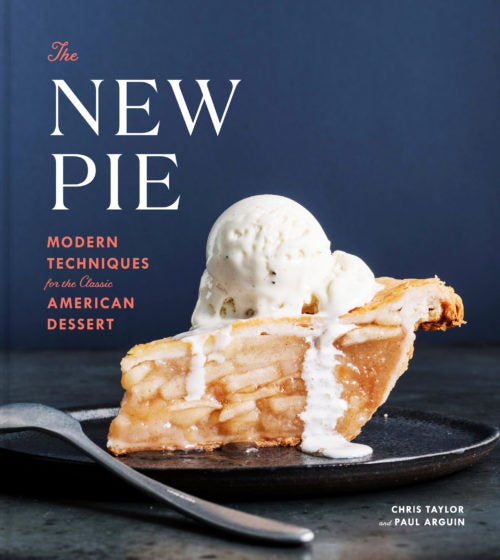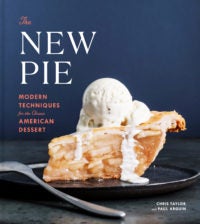Italian Plum Affogato
1
9 1/2-inch deep-dish pie
Dessert
Course
Print Recipe
Ingredients
Directions
Deep-Dish Single Crust
1 ½ c
all-purpose flour

1 ½ tsp
sugar

½ tsp
salt

⅛ tsp
baking powder

3 tbsp
plus 2 teaspoons vegetable shortening

8 tbsp
cold unsalted butter, cut into 8 pieces

1 tsp
apple cider vinegar

3 tbsp
plus 2 teaspoons cold water

MASCARPONE TOPPING
¾ c
heavy cream

⅔ c
sugar

2 tsp
instant espresso powder

1 tsp
vanilla extract

1 c
Mascarpone cheese, cold

Filling
1 md
Granny Smith apple

5 c
Italian prune plums, pitted and sliced (from approximately 2 pounds whole)

1 tsp
vanilla extract

2 tbsp
brandy

2 tbsp
finely ground quick-cooking tapioca, such as Minute

1 c
sugar

2 tbsp
instant espresso powder

⅛ tsp
salt

Supplies
Immersion circulator with water bath

Vacuum sealer

Pie crust shield or foil

Piping bag fitted with a Wilton #4B or other large star piping tip

Alice Medrich has a recipe for Italian prune plums poached in coffee and brandy served over vanilla ice cream. After stumbling across these plums in our farmers’ market, we tried her recipe and decided that this delicious concoction had to be converted into a pie. Thanks Alice! We’re happy to note that these plums have returned to our market every summer. If you can’t find these particular plums, the recipe also works with fresh apricots or thawed frozen sweet cherries.
Directions
Deep-Dish Single Crust
- Measure the flour, sugar, salt, and baking powder directly into the bowl of a food processor. Pulse the ingredients once or twice to combine them.
- Scatter the shortening across the top of the flour mixture in three or four roughly equal nuggets. Pulse three to four times until the shortening seems to be evenly dispersed into the flour. If there are still large visible clumps, pulse one or two more times.
- Scatter the butter pieces across the flour mixture, and pulse four or five times. At this point the flour should appear textured, like coarse cornmeal, with small (1⁄4-inch) tidbits of butter flecked throughout. If not, pulse one or two more times.
- If measuring all ingredients by volume (measuring cups), simply combine the vinegar with the cold water and drizzle all the liquid over the flour. If using a scale, place a liquid measuring cup with a spout on the scale and tare (zero out) the scale to subtract the weight of the measuring cup. Add the measured amount of vinegar to the cup (do not re-tare the scale); now add the cold water to the vinegar so that the combined vinegar plus water equals the weight of cold water listed in the ingredients. Drizzle the liquid over the flour in the food processor.
- Using 1-second pulses, process the mixture until it transforms from dry and powdery and just begins to form into a large clump of cohesive dough, five to eight pulses. Stop pulsing once most of the dough is clumped together. The dough may look like pebbly curds of cottage cheese and there may be unincorporated flour in the bowl. That is what you want at this point. If you process the dough until it forms one large ball of dough and starts thwacking around in the food processor bowl, it will be overworked and bake up tough.
- Transfer the dough and any remaining unincorporated flour to a smooth work surface (you can use a silicone rolling mat if you like, but we usually do this straight on the counter). To incorporate any loose flour, press and smear the flour across the work surface with the heel of your hand. Gather all of the dough and press it into a 5- to 6-inch disc about 1 inch thick. If making a double batch or a recipe for a double crust, divide the dough into 2 discs using the weights specified in the recipe.
- Wrap the disc(s) in plastic wrap, and smooth the outer 1-inch-thick edge with your fingertips or by rolling the disc along the countertop. These smooth edges will make the dough easier to roll out in a circle. Refrigerate for at least 4 hours but preferably overnight.
MASCARPONE TOPPING
- START THE MASCARPONE TOPPING: In a medium microwave-safe bowl, microwave the cream until it just starts to boil, 1 to 2 minutes, depending on the power of your microwave oven. Using a rubber spatula, stir in the sugar, espresso powder, and vanilla until the sugar and espresso are dissolved. Cover the bowl with plastic wrap and place it in the refrigerator until cold, at least 2 hours.
- MAKE THE FILLING: Set up the water bath for your immersion circulator and start heating the water to 150°F. Peel the apple and grate it using the coarse holes of a box grater. Discard the peels and core. Squeeze the grated apple to remove as much of the juice as possible and break up the clump of grated apple inside a large vacuum-sealable bag. Add the sliced plums, vanilla, and brandy to the bag.
- In a small bowl, whisk the tapioca, sugar, espresso powder, and salt until well mixed. Pour this mixture into the vacuum bag, and vacuum- seal it shut. Cook the plums sous vide in the water bath for 1 hour.
Partial Blind Baking
- Roll the dough to the specified diameter for the pie plate you are using. Remember that the target thickness for a bottom pie crust is 1⁄8 inch. Place the dough in the pie pan and crimp the edges as desired. Freeze the dough-lined pan for at least 20 minutes while preheating the oven to 350°F.
- Lightly spray one side of an 18-inch piece of aluminum foil with cooking spray. Line the crust with the foil, sprayed side down. Fill the pan with pie weights. For deep-dish crusts, use 6 cups. Completely cover the edges of the crust with the foil.
- For a partially blind-baked crust, remove the pie from the oven when the edge is a light golden brown, 40 to 50 minutes. Lift out the pie weights using the corners of the foil. The goal is for the inside of the pie shell to be just beginning to brown. If the pie is too pale, return the crust to the oven without the weights and continue to bake, checking every 2 minutes or until the bottom is just beginning to turn light golden brown in spots. The pie will bake longer after the filling is added, so it should not be completely browned at this point. Partially blind-baked crusts are usually filled hot out of the oven, so keep that in mind when preparing the pie filling.
- The pie will bake longer after the filling is added, so it should not be completely browned at this point. Remove the pie dish from the oven, set it on a wire cooling rack, and remove the foil or parchment and pie weights. Keep the oven at 350°F.
Filling
- FILL THE CRUST AND BAKE: Remove the plum bag from the water bath, and dry it off with a kitchen towel. Place a pie crust shield on the pie to prevent splashes. Cut open the bag and pour the filling into the warm crust. Use a bench scraper to get out all the juices. The filling will look quite loose at this point, but don’t worry; it will thicken up in the oven.
- Keep the pie crust shield on and bake on the bottom rack of the oven until the plum filling starts to gently bubble at the edges, about 25 minutes.
- Remove the pie from the oven, remove the pie crust shield, place the pie on a cooling rack, and allow the pie to cool completely, at least 4 hours, before serving.
Topping
- ADD THE TOPPING: When ready to serve the pie, complete the filling by adding the mascarpone cheese to the chilled espresso cream. Beat with an electric mixer until stiff peaks form, about 2 minutes. Spread this topping onto the chilled pie and smooth with an off set spatula or pipe it decoratively on top of the pie using the prepared bag. (Any leftovers can be stored in the refrigerator for up to 3 days.)
Reprinted with permission The New Pie by Chris Taylor and Paul Arguin, copyright © 2019. Published by Clarkson Potter, an imprint of Penguin Random House.

